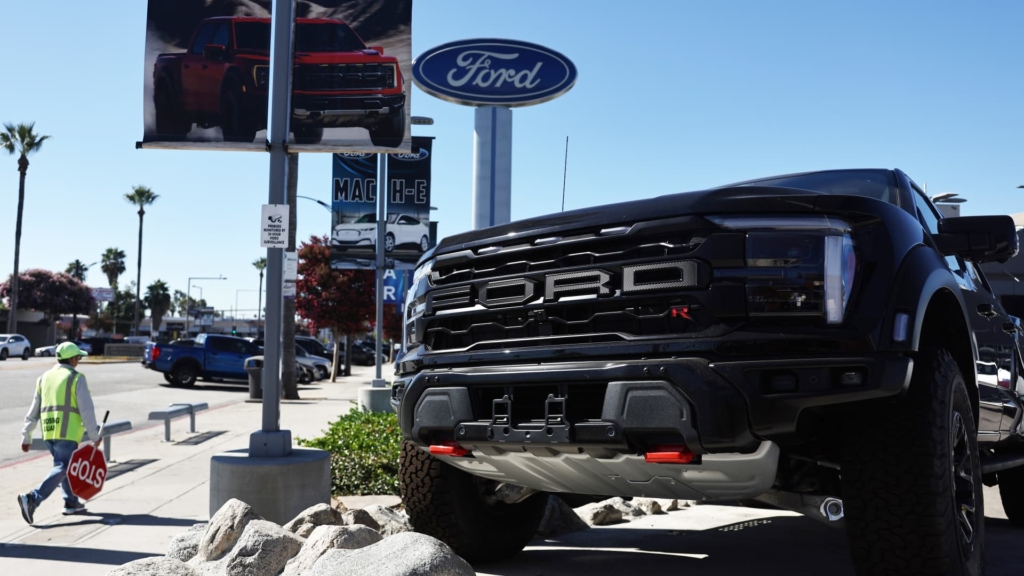DETROIT — As President Donald Trump’s 25% tariffs on imported vehicles prepare to take effect, Ford Motor executives are actively strategizing their response to the impending levies.
Amid ongoing uncertainty, Ford is moving swiftly by introducing an employee pricing initiative, titled “From America, For America”, aimed at U.S. customers.
Historically contentious, such pricing initiatives can result in selling vehicles near or even below the invoice prices set for dealers, thereby squeezing already narrow profit margins for retailers. Despite this, Ford is seizing the moment to reinforce its position in the U.S. market, which stands as the largest among automakers, while addressing rising consumer anxieties tied to Trump’s tariffs.
“We understand that these are uncertain times for many Americans. Whether it’s navigating the complexities of a changing economy or simply needing a reliable vehicle for your family, we want to help,” Ford stated in a press release on Thursday announcing the initiative. “We have the retail inventory to do this and a wide range of options for customers who need a vehicle.”
Industry analysts have remarked on this trend among automakers looking to find “opportunity in the chaos,” aiming to “capitalize on the moment” amid the evolving tariff landscape.
“I absolutely love it. I think it’s going to drive sales,” stated Ford dealer Marc McEver, the owner of Olathe Ford Lincoln near Kansas City, Kansas. “It’s really exciting to see Ford step up and take the lead on this program. I think it’s a great play… It’s truly a real deal for the customer.”
Ford has also committed financial support to dealers participating in the program, which was communicated to them just a day prior to the tariffs taking effect. The official announcement of the initiative was made just hours after the tariffs went live.
Leading up to the implementation of the tariffs, Ford was generally perceived by Wall Street analysts as one of the best-positioned automakers, particularly due to its extensive production capabilities in the U.S., especially in trucks.
In the wake of the tariff announcements, Ford’s stock price remained relatively stable, closing down just 1.4% for the week, in contrast to Chrysler parent Stellantis‘ 14.2% drop and General Motors‘ 5.4% decline during the same period.
Ford’s approach is being echoed by other automakers. Stellantis announced a similar employee-pricing program, while Hyundai Motor pledged to maintain current prices for a minimum of two months to assuage consumer concerns.
“It makes sense that they would try to capitalize on the moment,” Erin Keating, executive analyst at Cox Automotive, observed.
Keating noted that both Ford and Stellantis, the latter having significant operations in the U.S., are positioning themselves as “domestic” manufacturers to consumers. Furthermore, they are managing substantial inventories, including older vehicle models, that must be sold to clear space for newer products.
“Making room for those new vehicles to come into the showroom and trying to maintain that market share makes a lot of sense,” Keating explained. “Anyone who can adjust pricing in the current market dynamics will likely maintain their market share longer and possibly attract customers from competitors who do not meet their needs.”
According to Cox Automotive, Ford and Stellantis brands like Ram Trucks and Jeep have some of the highest inventory levels within the industry, indicating a substantial days’ supply.
In fact, these two automakers were among the few major brands to report significant declines in first-quarter vehicle sales. Stellantis saw a reduction of approximately 12%, while Ford’s sales fell by 1.3% year-on-year.
The national average for vehicle inventory days was reported at 89 days, whereas Ford and Stellantis brands showed inventory levels ranging from 110 to 130 days. This contrasts sharply with the generally accepted healthy inventory level, which is between 60 and 80 days.
As talks of tariffs and potential price increases loom, the demand for vehicles has surged. In the days leading up to the tariffs, many consumers rushed to dealerships, significantly boosting sales for several manufacturers.
Cox Automotive estimated that March’s new vehicle sales reached 1.59 million units, far exceeding expectations and marking the best monthly sales volume in four years.
“The last week, and including this past weekend, was by far the best weekend that I’ve seen in a very long time,” Hyundai Motor North America CEO Randy Parker noted during a recent media briefing. “There were a lot of people coming in, likely to try and beat the tariffs.”
By capitalizing on current consumer demand, automakers are enhancing their sales potential, particularly as concerns mount about a possible U.S. recession. J.P. Morgan recently elevated its recession probability projections for the U.S. and global economies from 40% to 60% by year-end.
“Given the current surge in demand, offering consumer incentives makes perfect sense. People are thinking, ‘I need to act now, before any potential downturns,’ so this is a strategic time to reap rewards,” Keating concluded.


























